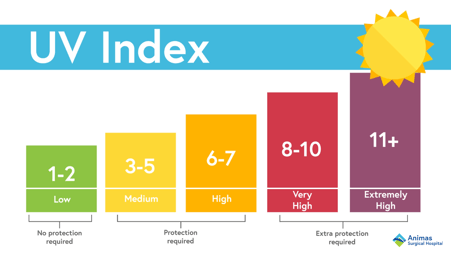What is the UV Index and what does it mean?
Did you know that it is not the sun's heat or light that burns your skin, but rather the UV radiation? We are often encouraged to check the UV Index before going outside to avoid getting sunburnt, which can contribute to skin damage and increase the risk of skin cancer over time. So what is the UV Index and what does it mean?
What is the UV Index?
The UV Index describes the daily danger of solar UV radiation intensity using a scale from 0 to 11+. Each point on the Index scale is equivalent to 25 milliWatts per square metre of UV radiation. Since UV radiation cannot be seen or felt, the Index is an important gauge to help us judge the likelihood of getting burnt if we were to go outside without protection.
How is the UV Index calculated?
If UV radiation is different to the sun's heat (which we can feel) and the sun's light (which we can see), then how is it calculated? A computer model uses the ozone forecast and the incident angle of sunlight at each point to calculate the strength of UV radiation at ground level. This information is graphed and forecast by various authorities, including the Australian Bureau of Meteorology and the SunSmart UV Alert.
What does it mean?
The UV Index is presented as a number from 0 to 11+. The higher the number, the stronger the levels of UV radiation and the more risk we have of being sunburnt.
| 0 - 2.9 | Low | A low UV Index reading means there is low danger from the sun's UV radiation for the average person. |
| 3 - 5.9 | Moderate | A moderate UV Index reading means there is moderate risk of harm from unprotected sun exposure. |
| 6 - 7.9 | High | A high UV Index reading means there is high risk of harm from unprotected sun exposure. Protection against skin and eye damage is needed. |
| 8 - 10.9 | Very High | A very high UV Index reading means there is very high risk of harm from unprotected sun exposure. Take extra precautions because unprotected skin and eyes will be damaged and can burn quickly. |
| 11 + | Extreme |
A UV Index reading of 11 or more means extreme risk of harm from unprotected sun exposure. Take all precautions because unprotected skin and eyes can burn in minutes. |

DID YOU KNOW?
The UV Index can be high even on cool or cloudy days. In fact, UV levels can be stronger on overcast days because the clouds reflect and intensify the rays. High temperatures are not an indicator of high UV levels.
Image: Animas Surgical Hospital
When are the peak times?
The UV Index fluctuates throughout the day. Levels peak between 10 am and 3 pm, so we should avoid going outside during these times or take action to protect our skin from the sun.
How can we protect our skin?
We should protect ourselves against UV radiation whenever the UV Index rises above 3. Remember that UV rays can reflect off bright surfaces, such as sand, concrete, glass, snow and water.
- Wear a broad-brimmed hat
- Wear SPF30+ sunscreen and reapply every two hours or more often if sweating or swimming
- Wear clothing that covers as much skin as possible, such as a collared long-sleeved shirt
- Wear sunglasses
- Seek the shade
- Avoid going outside if possible
If UV levels are less than 3, sun protection is not recommended unless you work outdoors, spend a great deal of time outside, or will be near reflective surfaces such as snow, sand or concrete.
You can check the UV Index every day on most weather sites, or download Cancer Council's SunSmart app.
Does sun protection increase the risk of vitamin D deficiency?
The sun's UV radiation is a major cause of skin cancer and also a significant source of vitamin D. We need to balance the risk of skin cancer from excessive sun exposure with maintaining adequate vitamin D levels, as insufficient vitamin D can pose a health risk. Adopting sensible sun protection habits (such as avoiding the outdoors when the UV Index is above 3), is unlikely to put most people at risk of vitamin D deficiency when sun protection is used sensibly. Read more about finding the right balance.
References
- Australian Radiation Protection and Nuclear Safety Agency. (2023). Ultraviolet radiation in Australia. Retrieved from https://www.arpansa.gov.au/understanding-radiation/radmap-aus/ultraviolet-radiation-in-australia
- Bureau of Meteorology. (2024). About the UV Index. Retrieved from https://www.bom.gov.au/resources/learn-and-explore/uv-knowledge-centre/about-the-uv-index
- Cancer Council Australia. (2023). UV Index and sun protection times. Retrieved from https://www.cancer.org.au/cancer-information/causes-and-prevention/sun-safety/uv-index
- Cancer Council Australia. (2023). Vitamin D and sun exposure. Retrieved from https://www.cancer.org.au/cancer-information/causes-and-prevention/sun-safety/vitamin-d
- WWorld Health Organization. (2002). Global solar UV Index: A practical guide (WHO/SDE/OEH/02.2). Geneva: WHO. Retrieved from https://www.who.int/publications/i/item/9241590076
- Tags:
- Prevention
